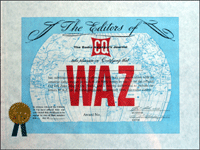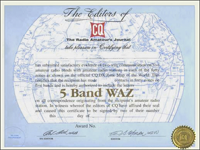Regulamento Diploma WAZ inglês
CQ Magazine Ckecker > WAZ > Regulamentos


Worked All Zones Award RulesSection 1. IntroductionThe CQ Worked All Zones Award (WAZ) and its variations are issued to any licensed Radio Amateur Station presenting proof of contact with all 40 CQ Zones.This proof consists of proper QSL cards; which in many cases may be checked by any of the authorized check points or sent directly to the WAZ Award Manager. (List of authorized check points is included elsewhere in these rules)The WAZ program is one of the longest running in ham radio, having its start prior to WWII.While the WAZ program involves the use of "DX Entities," it does not rely on any particular "Entity's" status as a country. The WAZ award is geographically focused, which is where its challenge lies.WAZ Award correspondence can be directed to the WAZ Award Manager:John Bergman, KC5LKP.O. Box 792Brandon, MS 39043 USAe-mail: kc5lk@cq-amateur-radio.comApplication Form, Rules and Zone Map are available in .PDF format from the CQ Magazine WAZ Rules web pageThis information is also available from either the WAZ Award Manager or CQ Magazine in hardcopy. Mail your request for WAZ information to either of the addresses shown above. Please include a business size SAE with two units of postage (for US stations) or $2.00 with your request. Foreign stations may supply a return mailing label and 1 IRC. Please indicate on the back of your envelope "WAZ Info Request" so we can spot your letter more easily and reply quickly.Section 2. General RulesAll QSO's must be made by a licensed Amateur Radio Operator, from a licensed Amateur Radio station, using only modes of emission and transmitter output power as permitted by the local licensing authority. QSO's with stations other than Radio Amateur (such as MARS, Commercial or Military) are ineligible for the WAZ award.All QSO's must be conducted within the radio spectrum as authorized for that licensee by the local licensing authorityAny WAZ applicant found to be operating outside the bounds of their license may be disqualified from the WAZ program.All contacts must be made from within the same DXCC Entity.QSO's made by the same applicant using previous callsigns from that same DXCC entity are acceptable. Proof of holding those previous callsigns is requested.The Official CQ WAZ Zone Map and the printed zone list are used to determine the zone in which a station is located.If a problem is found with your application or QSL cards, we will attempt to contact you via e-mail to inform you of the issue and attempt to resolve it with you. We REALLY don't want to return your application if we don't have to.The submission of any WAZ award application acknowledges consent to abide by the decisions of the CQ WAZ Manager and the CQ Awards Committee.Decisions of the CQ DX Advisory Committee on any matter pertaining to the administration of this award are final.Section 3. QSO's and QSL'sAll QSO's must be two-way with both stations using the same mode of emission.QSL Cards must include:1. Callsigns of both stations2. Date of QSO3. Time of QSO (UTC preferred)4. Band or Frequency of QSO5. Mode of QSO6. The QTH of the station worked (country, state, city). Indication of the CQ zone is optionalQSL Cards not including the information above may be returned to the applicant for replacement, and not credited towards the WAZ award.Electronic verifications from sources approved by CQ are acceptable. See the CQ website for acceptable online sources.Ineligible QSOs:Cross-BandCross-ModeAeronautical MobileMaritime MobileStations located on floating iceShips anchored in portAny altered or forged confirmations submitted by an applicant for WAZ credit may result in permanent disqualification. The WAZ Manager may request the resubmission of certain confirmations. While a QSL card is normally accepted as proof of a contact, the final proof is an entry in the DX station's logbook for the listed QSO.The failure to resubmit QSLs in a timely manner when requested by the WAZ Manager may result in the recall of the award in question.Section 4. WAZ Award TypesWAZ By ModeMode | QSOs on or After | Field Checking | NotesAM 14 November 1945 YesSSB 14 November 1945 YesCW 14 November 1945 YesRTTY 14 November 1945 YesSSTV 01 January 1973 YesDigital 01 January 2000 Yes See Note 2Satellite 01 January 1989 No See Note 4EME 01 January 1973 No See Note 4WAZ By BandBand |Mode | QSOs on or After | Field Checking |Notes160 Meters Mixed Only 01 January 1975 No See Notes 3 & 480, 40, 20, 15, 10 Any Single Mode 01 January 1973 Yes No Mixed Mode30 Any Single Mode 01 January 1991 Yes No Mixed Mode17 Any Single Mode 01 January 1991 Yes No Mixed Mode12 Any Single Mode 01 January 1991 Yes No Mixed Mode6 Mixed Mode 01 January 1973 No See Note 4WAZ By TechnologyType | QSOs on or After |Field Checking | NotesTraditional (Local control) 14 November 1945 Yes See Note 5Remote (combined local/remote) 14 November 1945 for local-control QSOs 01 January 2015 for remote QSOs Yes See Note 5All-Remote 1 January 2015 Yes See Note 5Note 1: The process of endorsing a CW/Phone WAZ Award has been discontinued. The old CW/ Phone WAZ Award has been renamed MIXED Mode WAZ. The existing CW/Phone WAZ award numbering sequence has been discontinued in support of this change.Note 2: This WAZ award is designed to encourage activity and experimentation using any of the digital modes available to amateurs. The list includes, but is not limited to, PSK-31, AMTOR, PACTOR, and Spread Spectrum. QSL cards must indicate the specific mode used for the QSO. RTTY does not count for this award, as it has its own award. This award will not be endorsed for any specific digital mode. You may elect to use a single digital mode or different digital modes in working toward this WAZ award.Note 3: The 160 Meter WAZ Award requires that the applicant submit QSL cards from at least 30 zones. Endorsement stickers are issued at the 36, 37, 38, 39, and 40 zone levels.Note 4: The Satellite, EME and 6 Meter WAZ Awards require that the applicant submit QSL cards from at least 25 zones. Endorsement stickers are issued at the 30, 35, 36, 37, 38, 39 and 40 zone levels. The Satellite and EME Awards are not band specific; you may apply QSOs from multiple bands. Applications and cards for these awards must be submitted to the WAZ Award Manager.Note 5: There are three technology categories recognized for the WAZ Award: Traditional, Remote and All-Remote.TraditionalThe operator is physically present at the station location (location of transmitter, receiver and antenna) for all contacts. All contacts must be made from within the same DX entity.Remote - The operator uses remote station technology to make one or more claimed contacts on or after January 1, 2015. All contacts must be made from within the same DX entity. Remote WAZ awards will be numbered separately from Traditional awards.All-Remote - The operator uses remote station technology on or after January 1, 2015 to make all claimed contacts. All contacts must be made from within the same DX entity. All--Remote WAZ awards will be numbered separately from Traditional and Remote awards.Special EndorsementsAll CQ DX Awards, USA/CA and WAZ Awards (except 5BWAZ and 160 WAZ) may be endorsed for unique situations, as provided for in the rules for each specific award, such as all QRP or all mobile provided the application includes an additional signed statement from the applicant that so states it was done via QRP or /M.There is no special numbering system for these awards and they must still meet all the other requirements for CQ Awards.5 Band WAZApplicants who succeed in presenting proof of contact with the 40 zones of the world on each of the 80, 40, 20, 15 and 10 meter bands (for a total of 200) receive a special certificate in recognition of this achievement. There are separate numbering tracks for Traditional, Remote and All-Remote 5BWAZ Awards.NOTE: A prerequisite for 5 Band WAZ is that the applicant must already be a holder of any 40-zone WAZ. THE NUMBER, DATE, AND AWARD TYPE MUST BE INDICATED ON THE 5BWAZ APPLICATIONThe first plateau is a total of 150 zones across any combination of the 5 bands listed above. A certificate will be issued with a unique award number, indicating the initial number of zones confirmed.After reaching the150 zone plateau, each 10 zones requires the submission of QSL cards and the application fee.Upon reaching 200 zones confirmed, the applicant will be issued a 200 zones endorsement sticker to affix to their 5BWAZ certificate that was previously issued. No other endorsement stickers are issued.Upon reaching the 200 zones level, the applicant may wish to purchase an engraved plaque to acknowledge the achievement.MODES: Mixed Mode ONLY. The 5 Band WAZ Award is not available for any single mode.QSLs accepted: Contacts for Traditional 5BWAZ must have been made after 0000Z January 1, 1979. Contacts for Remote or All-Remote 5BWAZ must have been made after 0000Z January 1, 2015.Card checking: Checking of 5BWAZ awards by CQ awards checkpoints is available for initial applications of up to 170 cards.Applicants wishing to submit more than 170 cards may do as follows:Submit 170 cards to a checkpoint. Once these cards are approved and the application is signed by the checkpoint, another application can be prepared for the additional cards (as an endorsement). The original application (signed by the checkpoint) must be submitted along with the endorsement application and cards to the WAZ Award Manager.ALL QSLS TO ENDORSE A 5BWAZ AWARD MUST BE PRESENTED TO THE WAZ AWARDS MANAGERApplication forms: CQ form 1479 or a facsimile shall be used. A separate application form is required for each band.NOTE: For Multi-band QSLs please include a summary sheet indicating the callsign and bands for each particular card. This will aid in checking of QSL cards.
